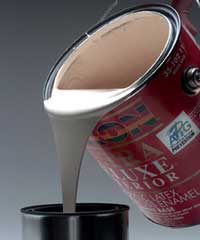
Vol. III, No. 9, September 2004
- The Importance of Nature for Young Children
- Exploring the Natural World Video
- Impact of Space and Color in the Physical Environments on Preschool Children's Cooperative Behavior
- Environmentally and Kid-Safe Wall Paints
- Looking for Money for Your Facility?
- Can't Make it to the Design Institute in January? Attend the Workshop on Creating Environments
- Recent Projects
- Upcoming Institutes
Environmentally and Kid-Safe Wall Paints
 To
child care directors, facility planners and designers, the most important
factor for wall paint to be considered environmentally and child friendly
is that is contains a low amount of volatile organic compounds (VOC) in its
solvent. The solvent holds the pigment and resin in solution when paint is
applied. As the paint dries, the solvent slowly evaporates into the surrounding
air. VOCs, such as benzene, formaldehyde and toluene, are added to the solvents
to help the paint dry faster. When VOCs evaporate, they contribute to the
formation of smog and are responsible for the "new paint smell".
Some evidence also suggests that VOCs may be carcinogens. Certainly VOC emissions
can play havoc with young children's developing neurological systems.
Selecting low VOC paints can bring a major improvement of indoor air quality
compared with higher VOC level paints.
To
child care directors, facility planners and designers, the most important
factor for wall paint to be considered environmentally and child friendly
is that is contains a low amount of volatile organic compounds (VOC) in its
solvent. The solvent holds the pigment and resin in solution when paint is
applied. As the paint dries, the solvent slowly evaporates into the surrounding
air. VOCs, such as benzene, formaldehyde and toluene, are added to the solvents
to help the paint dry faster. When VOCs evaporate, they contribute to the
formation of smog and are responsible for the "new paint smell".
Some evidence also suggests that VOCs may be carcinogens. Certainly VOC emissions
can play havoc with young children's developing neurological systems.
Selecting low VOC paints can bring a major improvement of indoor air quality
compared with higher VOC level paints.
Because of the reduction of health related risks for young children, low or
no VOC paints can allow facilities to maintain a normal operation while painting
is underway. The amount of VOCs a paint can contain is determined by the nature
of the paint and its intended use. Green
Seal certifies interior flat paints that contain a maximum of 50 grams
of VOCs per liter of paint and interior flat paints that contain a maximum
of 150 grams of VOCs per liter of paint. In addition to the low-VOC requirements,
paints must meet other performance-based criteria such as abrasion resistance,
hiding power, and the ability to be washed and scrubbed to be eligible for
Green Seal certification.
One of the downsides to high-performance, low-VOC paints is that they usually
carry a higher price tag. However, selecting such paints can reduce the number
of times a facility needs to be painted over a 20-year span. It is also important
to remember that low VOC paints take longer to cure and dry since much of
the VOC-containing drying and curing agents are removed
Vol. III, No. 9, September 2004
- The Importance of Nature for Young Children
- Exploring the Natural World Video
- Impact of Space and Color in the Physical Environments on Preschool Children's Cooperative Behavior
- Environmentally and Kid-Safe Wall Paints
- Looking for Money for Your Facility?
- Can't Make it to the Design Institute in January? Attend the Workshop on Creating Environments
- Recent Projects
- Upcoming Institutes

